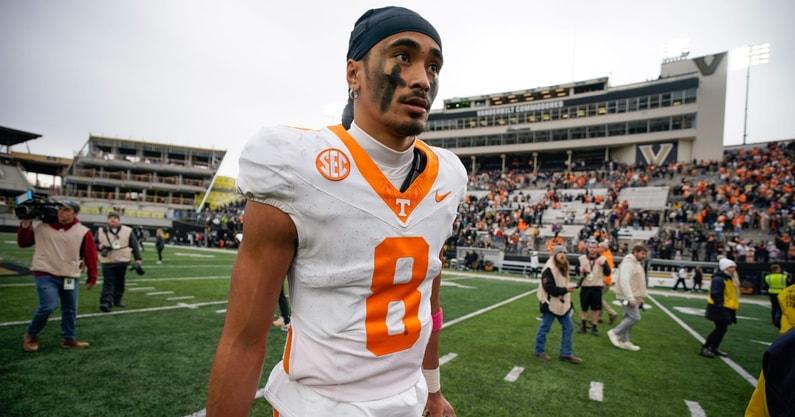
A football player exits the field after a game, surrounded by a cheering crowd in the stands.
The High-Stakes Game: How Sports Agents Are Competing for Top College Football Transfers
The college football transfer portal has transformed from a simple roster management tool into a multibillion-dollar marketplace where sports agents vie for the services of elite student-athletes. With name, image, and likeness (NIL) deals now reaching into the millions, the competition among agents to represent top transfer portal targets has reached unprecedented intensity.
The landscape of college football fundamentally shifted when the NCAA adopted its NIL policy in July 2021, allowing student-athletes to monetize their personal brands. This change, combined with the liberalization of transfer rules, has created a perfect storm where agents now play a crucial role in shaping college football’s competitive balance.
The Million-Dollar Athletes
Today’s top college athletes command NIL valuations that rival professional rookie contracts. Texas quarterback Arch Manning entered the 2025 season with NIL projections of $6.8 million, though his value has since adjusted to $3.6 million based on performance [Source: Sports Illustrated]. Ohio State receiver Jeremiah Smith now leads college football with NIL projections of $4.2 million, demonstrating the fluid nature of athlete valuations in this new era.
The competition for these lucrative athletes has intensified the tactics agents employ to secure top transfer portal talent. Agents are no longer just negotiating deals—they’re becoming strategic advisors who help athletes navigate complex decisions about their collegiate careers and professional futures. Agents are particularly focused on players considered future top 50 NFL draft picks, recognizing that a successful transfer can significantly impact draft stock [Source: Sporting News].
Creative Deal-Making in the NIL Era
The NIL marketplace has created new opportunities for creative deal structures. Leading athletes like Arch Manning have secured partnerships with major brands including Warby Parker, EA Sports, Vuori, and Waymo [Source: Sporting News]. These diverse portfolio approaches allow agents to maximize their clients’ earning potential while maintaining eligibility.
Technology companies are increasingly facilitating these transactions. Venmo has become instrumental in helping college athletes receive payments, with PayPal’s chief corporate affairs officer Amy Bonitatibus noting the platform’s growing role in the NIL ecosystem [Source: Business Insider]. This technological infrastructure has made it easier for agents to manage complex payment structures across multiple deals.
The Transfer Portal Chess Match
The transfer portal itself has become a strategic chess match where timing is everything. Agents must carefully orchestrate their clients’ entries into the portal, balancing current team commitments with future opportunities. They analyze depth charts, coaching changes, and program trajectories to identify optimal landing spots that maximize both playing time and earning potential.
The best agents maintain extensive networks across college football, leveraging relationships with coaches, boosters, and NIL collectives to create opportunities for their clients. This requires deep understanding of each program’s culture, resources, and competitive trajectory—knowledge that separates elite agents from the pack.
Disrupting Traditional Recruiting
This new reality has raised concerns about its impact on college football’s traditional recruiting model. UConn coach Geno Auriemma has expressed concern that the transfer portal has become prioritized over high school recruiting, fundamentally altering how programs build their rosters [Source: Sports Illustrated]. This shift has created additional opportunities for agents, who now represent a broader pool of college athletes seeking transfers rather than just those preparing for professional careers.
The financial stakes continue to escalate as NIL collectives and corporate sponsors pour resources into attracting top talent. Agents must navigate this complex ecosystem while ensuring their clients maintain academic eligibility and comply with NCAA regulations. The most successful agents have assembled teams including marketing specialists, financial advisors, and compliance experts to provide comprehensive services to their athlete clients.
The Hidden Workforce Behind College Football
While conversations about college football often focus on multimillion-dollar coaching contracts and star players’ NIL deals, there’s now an entire industry of professionals working behind the scenes to facilitate these transactions [Source: The Rebel Walk]. Sports agents have emerged as key players in this ecosystem, wielding significant influence over where top talent lands and how much they earn.
Looking ahead, the competition among agents for top transfer portal talent shows no signs of slowing. As more states legalize sports betting and NIL opportunities expand, the financial incentives driving this marketplace will only grow stronger. The agents who can best navigate this evolving landscape—balancing athlete development, brand building, and strategic career planning—will continue to attract the most coveted clients in college football’s new professional era.
For NCAA fans watching this transformation unfold, understanding the role of sports agents provides crucial context for transfer decisions that reshape conference power dynamics and championship races. What was once a relatively simple process of changing schools has evolved into a sophisticated business operation where agents compete as fiercely as the programs themselves for the services of elite college football talent.

